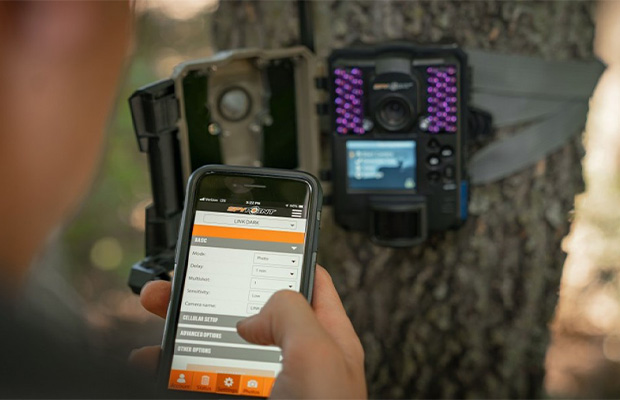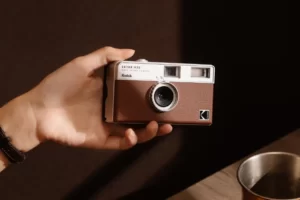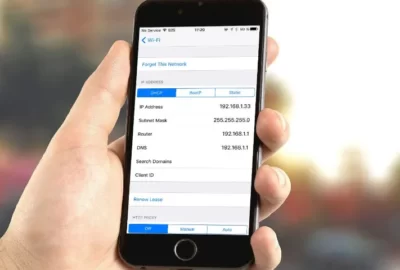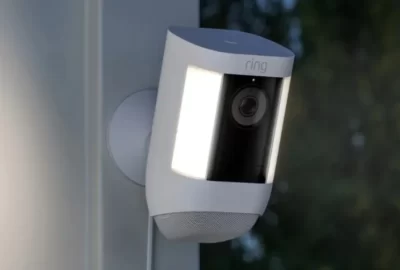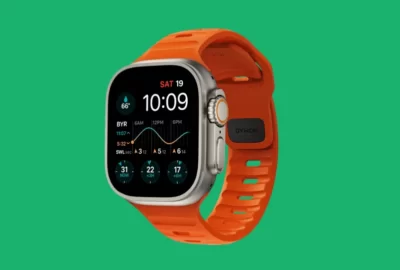10 Best Cellular Trail Camera in 2023: Complete Buying Guide
Monitor and shoot wildlife remotely, using the best cellular trail camera around today. To assist you in choosing the ideal camera, we tested the newest models this year.
Remember that you will make other investments in addition to the device you buy. Individual cell plans with recurring fees are available with trail cameras.
Below are some top picks we choose from the market:
- 1. Best Overall: Reconyx Hyperfire 2 Celluar
- 2. Best Picture Quality: Tactacam XB
- 3. Best for the Money: Moultrie Mobile Edge
- 4. Bushnell Cellucore 20
- 5. Covert 2021 Blackhawk LTE
- 6. Stealth Cam DS4K Transmit
- 7. Spypoint Flex
- 8. Wildgame Terra Cell
- 9. Browning Defender Pro Scout Max
- 10. Muddy Manifest 2.0
When you’re on the go, wherever you are, good cellular trail cameras are ideal for remote wildlife monitoring. These tiny cameras, also called camera traps, are made to be positioned in a natural setting and left to record animals as they move by.
We’ve sorted through the marketing bluster to select the top cellular trail cameras for 2022 after spending weeks setting up and testing the most recent models.
You May Also Like: Best Disposable Camera
Best Cellular Trail Camera Reviews 2023
1. Best Overall: Reconyx Hyperfire 2 Celluar
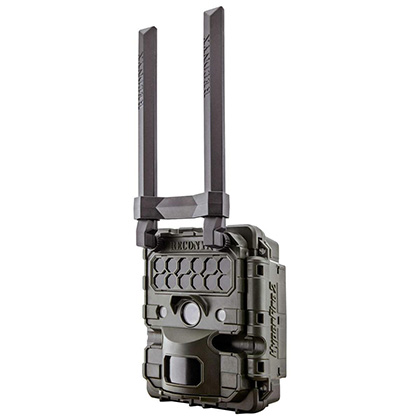
Why It Made the Cut
This high-performance camera comes with a five-year warranty, a lightning-fast trigger speed, and impressive night vision.
Key Features
- 12 AA lithium batteries
- 0.2 second trigger speed
- Advertised detection range: 100 feet
- Made in the USA
- Five-year warranty
Pros
- High quality photos and performance
- Excellent warranty and durability
- Fast trigger speed
Cons
- App crashed
- Records video, but doesn’t transmit through cellular
- Expensive
Reconyx trail cameras are used by the majority of reputable wildlife researchers for a reason: their cameras consistently produce high-quality images and function without issue. Hardcore hunters looking for that kind of performance ought to think about the Hyperfire 2. In the walk-through test, this camera did well, triggering out to 60 feet both day and night and also catching me up close. Importantly, it was the only camera that could effectively stop motion at a close distance while it was dark (you can see that picture below). This is crucial, as you already know if you’ve looked through nighttime pictures from the rut. It is frequently impossible to count points on a photo of a buck that runs directly in front of the lens because it appears as a white blur. With the Reconyx, that won’t be as much of a problem.
Additionally, the Hyperfire 2 performed admirably in the field, capturing a number of images of a buck as he slithered through a Wisconsin property’s tall green grass. The field photos taken at night were excellent. It’s also important to point out that during the walkthrough test, the camera was essentially silent. I could hear other cameras firing at close range, and at night, I could see a 60-foot-distance bright red flash. The Reconyx was an exception to this rule. Both a visible flash and any kind of trigger noise were absent.
Only two minor issues with the camera bother me. When I first began using the app, it crashed several times. Three times, I had to uninstall and reinstall the app. I read a number of reviews in the app store where users had the same complaint. Thankfully, all of my photos were saved in my profile, and it appears that Reconyx has found a solution. I’ve been using the app without any problems for about a month now. Second, for a few days, the camera did fog up. A condensation spot was discovered inside the housing when my friend went to check on the camera after I received a few foggy pictures. Although the camera continued to operate and the photos are now clear, we did manage to capture a few days of foggy images. This is the best mobile trail camera you can purchase, barring price considerations. —A.R.
2. Best Picture Quality: Tactacam XB
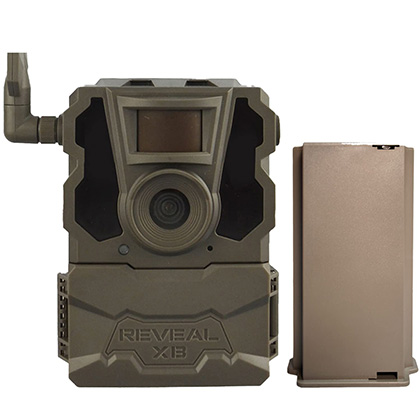
Why It Made the Cut
The Tactacam XB offers remarkable photo and video quality at a fair price.
Key Features
- 12 AA Batteries
- Less than 0.5 second trigger speed
- Flash range: 80 feet
- Advertised detection range: 96 feet
- LTE/4G wireless module
- 12 AA Batteries
- IP66 waterproof certified
- External port for solar panel
Pros
- Reliable
- Simple to set up
- Excellent photo quality
Cons
- Cell data plans are expensive per camera
- Requires a class 10 U3 SD Card
- Limited HD downloads on the app
We tested both the Tactacam X and XB, but we’ll concentrate on the XB because it adds a few more features. The focus of this camera’s narrative is the caliber of its images. Only extremely dense fog was able to fool this camera out of the thousands of images we examined. On a Wisconsin property, the XB captured stunning daytime pictures, and in Kansas, the X recorded thousands of high-quality pictures. Even though the XB is a “no glow” camera, it’s nighttime photos on par with other cameras in its price range.
The camera caught images of me during the walkthrough test at 10 feet and 60 feet during both day and night. Although the app is simple to use, I wish there were a few more options for categorizing and filtering photos. The camera does have a built-in GPS, allowing you to use the app to locate it. —A.R.
3. Best for the Money: Moultrie Mobile Edge
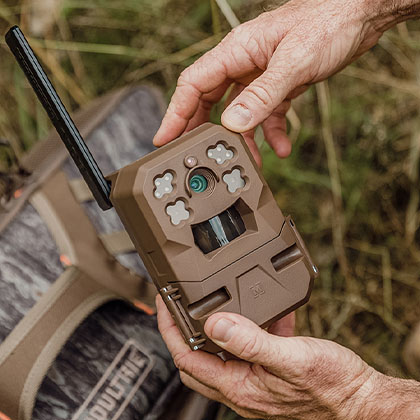
Why It Made the Cut
The Moultrie Edge offers remarkable features and reliable performance at a fraction of the cost of comparable cameras.
Key Features
- 16 AA
- 0.85 trigger speed
- Advertised detection range: 80 feet
- Free unlimited cloud storage
- Internal memory (no SD card)
- SmartTags for species and buck recognition
Pros
- Awesome features
- Easy setup
- Affordable for a cell cam
Cons
- Slower trigger speed
It is impressive that the Moultrie Mobile Edge is a functional, capable camera for only $100. The features that this cellular trail camera offers via its Moultrie Mobile app, however, are what make it truly remarkable. Without requiring you to change SIM cards, the camera quickly and automatically connects to the area’s strongest network. The cool thing is that because the Moultrie Mobile app is built with image recognition, it can recognize deer, including bucks vs. does), turkeys, vehicles, and humans in photos. You can then sort your images based on the species. Imagine that you set up your camera in the summer and by November you have a few thousand pictures, including some shooter bucks, does, squirrels, coyotes, and that damn neighbor who keeps passing by on his ATV. You can filter images in the app to only see pictures of deer, if you want. Additionally, it provides activity information that reveals the most frequent times that deer pass by the camera.
On the perimeter of our hunting property, I hung my test camera over a cornfield. The app claims that 6 a.m. is when this site experiences the most activity from hunters. (In order to verify that the app was accurate, I manually reviewed the photos; it was. The activity data takes into account temperature and moon phase in addition to time of day. If you take deer hunting seriously, I’m sure you already understand the amazing potential of this technology. You could have a powerful data set showing when bucks are moving based on the season, time of day, temperature, and moon phase with a few cameras running on a hunting property over the course of several hunting seasons. This camera will help you pattern deer activity in your area so you can have a lifetime of successful hunting, not just pattern a particular buck.
The Moultrie Edge’s only drawback is a marginally slower trigger response time. It had a difficult time catching me at the 10-foot walkthrough (I was almost out of the picture). At the 60-foot range during the day, it also missed me. During the nighttime walkthrough, the camera did a good job of capturing me at a 60-foot distance and creating sharp nighttime images. Additionally, the camera appeared to be unaffected by its slower trigger speed in the field because it consistently takes several pictures of passing deer. —A.R.
4. Bushnell Cellucore 20
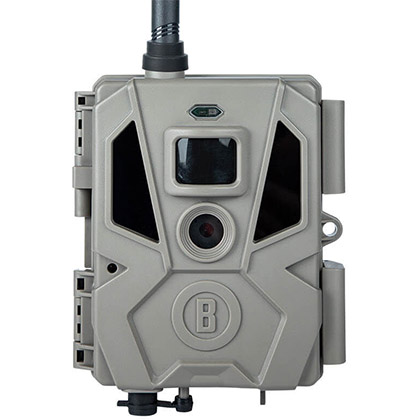
Why It Made the Cut
This camera, which costs around $100, has good features, a user-friendly app, and a long battery life.
Key Features
- 12 AA
- Less than one second trigger speed
- Advertised detection range: 80 feet
- Accepts up to 32 GB SD card
- Low glow
- 20 MP photo and HD video
Pros
- Easy-to-use app
- Triggered at 60 feet at night
- Customizable flash
- Solar compatible
Cons
- Inconsistent triggering at far distances
The Bushnell Cellucore 20 is one of the best cell camera buys, offering 20 MP photos, a programmable low glow flash, and an intuitive app for less than $100.
The Cellucore successfully triggered at 10 feet during the walk-through test, capturing a perfectly centered image day and night. During the day, the camera didn’t capture me at 60 or 100 feet, but at night, it took a series of five pictures of me moving at 60 feet.
There are three flash settings on the Cellucore: short range, fast motion, and long range. During the walk-through test, I used the long-range flash setting, which had a 43-yard illumination range. Close objects will be overexposed as a result of the long-range flash’s drawback. The fast-motion flash produced evenly illuminated photos with good detail from 5 to 15 yards during my in-field testing. It also captured several deer moving without much blur.—S.E.
5. Covert 2021 Blackhawk LTE
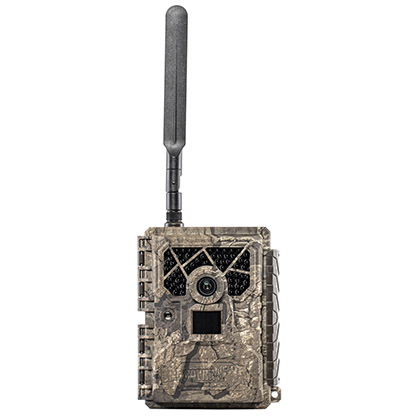
Why it Made the Cut
The Covert 2021 Blackhawk LTE is a versatile, user-friendly, and long-lasting cellular trail camera. The Covert app allows customization with camera “working” times.
Key Features
- 12 AA batteries
- 0.65 second trigger speed
- 60 no glow LED’s
- 2-inch color viewer
- 100-foot flash range
- GPS function
Pros
- Battery life is very good with high quality image mode and lithium AA batteries
- Custom “Working” operating times in Covert App
- True no glow IR
Cons
- 100-foot flash range is closer to 60 feet with average clarity
- Video mode trigger speed is extremely slow
- False triggers in detection at night
The operational customization available within the app was one of the primary factors in our decision to name the Covert 2021 Blackhawk LTE as one of the best cell cameras. The camera’s operational and photo-taking hours can be customized. The already excellent battery life can be greatly increased by doing this. There is no doubt that a set of lithium AA batteries can operate this camera for 12+ months with custom work times. Excellent accessories are available for this camera from Covert. This camera can be configured for instant trigger or hourly transfer times, and it can be powered by solar energy and rechargeable batteries if you have a deer hunting property where you maintain feeders. You can set up the camera with the help of the 2-inch color viewer built into the body.
Only $20 per month is charged for each camera under the unlimited plan on the Covert online management page. Which, in the current economic climate, is very doable given that the time and gas required to check the camera once a month will probably total more than $20. —D.P.
6. Stealth Cam DS4K Transmit
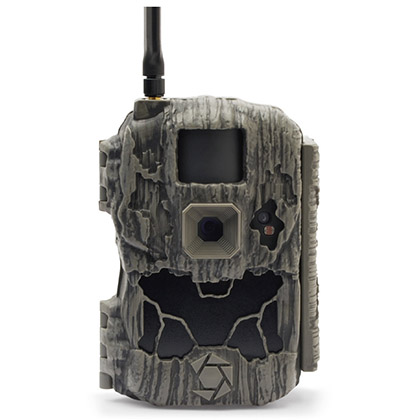
Why It Made the Cut
This camera has a free 30-day plan, 4K video recording capabilities, and a variety of photo settings.
Key Features
- 12 AA batteries
- 0.2 trigger speed
- Advertised detection range: 100 feet
- Burst mode of 1 to 9 images
- Solar power pack compatible
- App monitors activity by day and weather data
Pros
- Wide variety of photo and video options
- Lots of customization through the app
Cons
- App failed to pair with camera during setup
- Mediocre nighttime photos
The camera did not successfully sync with the app during setup, so let’s start with that. I called customer service after getting an error code. I spoke with a very polite representative who couldn’t figure out the problem and assumed that I had a defective SIM card. I gave up on the hold wait after two hours.
Let’s put the bad sim card aside and concentrate on the positives: this camera has an abundance of intriguing photo and video settings. Four different photo resolutions (up to 32MP) and four different video resolutions (including 4K) are available. Additionally, it has an intriguing feature that enables you to record between one and nine images per trigger while shooting in burst mode. In burst mode, other cameras frequently take three, or even five, pictures.
The Stealth Cam did a good job of capturing me up close and at a distance of 60 feet during the walkthrough test. Nevertheless, compared to other top cameras in this test, the quality of the nighttime photos was not as good. In the field, it did capture photos of a high caliber. —A.R.
7. Spypoint Flex
Why It Made the CutThe Flex takes good photos and connects to the carrier with the strongest signal using a dual SIM card.
Key Features
- 8 AA batteries
- 0.5 second trigger speed
- Flash range: 100 feet
- Advertised detection range: 100 feet
- 0.3 second trigger speed
- 33 Megapixels
- 1080p video with sound
- 2 SIM cards included
Pros
- Good videos
- Good night photos
- Easy to use
- GPS enabled
Cons
- Receiving full HD video costs extra
Throughout the course of a month, I moved a SpyPoint Flex between feeding areas, mock scrapes, and travel lanes. Although it costs almost twice as much as some of the less expensive trail camera options, it offers enough performance to make up for the cost. It produced some really cool video with audio and took excellent photos both during the day and at night. I’ve only had a very small number of blank photos with it.
Like many hunters, I use my cameras in areas with one or two bars of service, and the Flex still sent photos consistently. The most recent development in cell cam technology is the capability to automatically select the network with the strongest signal. Although you’ll only find it on more expensive cameras, it’s cool to see it in the Flex, which costs about $130.
The Flex triggered at 10 and 60 feet during my walkthrough test, but only reliably once at 60 feet. It did manage to take pictures of me that were motion-free and completely in the frame. —S.E.
8. Wildgame Terra Cell
Why It Made the Cut
A reasonably priced, simple to set up, and use camera is the Terra Cell.
Key Features
- 8 AA batteries
- 0.7 second trigger speed
- Advertised detection range: 80 feet
- Compatible with solar panel
Pros
- App includes image recognition software
- Affordable price point
Cons
- Subpar performance in walkthrough test
- Subpar nighttime images
- Antenna didn’t stay up
With a retail price of $120, Wildgame’s Terra Cell is competitively priced with other low-cost cell cams in this test. The Terra Cell, however, didn’t perform as well as those rivals did. The camera did not activate at 60 feet during either the day or the night of the walkthrough test. Even though the image quality at night was not very good, it did a nice job of getting me in the center of the frame at a distance of 10 feet.
Happier news: although it doesn’t present the information as clearly as the Moultrie Mobile app, the HuntSmart app lets you sort photos by species and time of day. However, if you’ve been using Wildgame cameras for a while and want to upgrade to the cellular version, this would be a good choice to hang close to a feeder, food plot, or significant natural food source. —A.R.
9. Browning Defender Pro Scout Max
Why It Made the Cut
Excellent battery life, simplicity of use, and picture quality at a price that rivals the competition.
Key Features
- Trigger speed: 0.25 seconds
- Detection range: 120 feet
- Power: 8AA batteries
Pros
- Second-best trigger speed in the test
- Simple to set up and use
- Excellent picture and video quality
- Battery life on Brownings is typically among the best in the category
Cons
- Not the best reception in all areas (Browning wireless models have external antennas that allow installation of a booster for areas with iffy reception)
It came as no surprise to me at all that this camera performed well. The trigger speed rivals the Reconyx, and the photos are some of the sharpest and clearest night photos I’ve ever seen. Also among the best in the test are the detection range and battery life.
Although I haven’t used this camera in a while, there’s no reason to think that it will perform any differently from its predecessors in terms of battery conservation (which is important to take into account when battery prices have increased by at least 30%). Browning cams are simply some of the most dependable in the industry, and if I were to run a string of wireless cams, I wouldn’t think twice about purchasing a number of Defender Pro Scouts. This camera offers impenetrable performance at an astoundingly low cost.
10. Muddy Manifest 2.0
Why It Made the Cut
This is a good option for any hunter on a tight budget because it comes in at a reasonable price and has data plans.
Key Features
- Trigger speed: 0.8 seconds
- Detection range: 80 feet
- Power: 8AA batteries
Pros
- Super simple setup
- Solid day pics
- Reasonable price point and data plan
Cons
- Slow trigger speed
As the Muddy are built on a similar platform and run off the same app (which is actually quite nice), if you’ve used Stealth cams before you’ll feel right at home using them. Other than that, not much fancy going on; just a reliable wireless camera that takes decent close-up photos, sends them to the app, and is reasonably priced. I’ve seen the Muddy for sale for around $100, and if you can get it for that price, it’s a good deal.
Things to Consider before Buying a Cellular Trail Camera
Ease of Setup
Although the majority of cellular trail camera manufacturers have acknowledged that not all of their customers are 25 years old and were given smartphones at birth, some have not. Cellular cameras should have simple programming interfaces and come with detailed instructions. All of the cameras I tested were controlled by an app, where you can also send pictures and change camera commands and settings. This is different than the original wireless cams, which typically sent images to the user via text (one of my buddies still refers to wireless cams as “texting cams” for this reason). It’s crucial how simple it is for these apps to install, operate, and monitor the camera.
Picture Quality
This can be related to price (i.e., the better the pictures, the more you pay), but not always. I promise you that after a while, the novelty of receiving pictures on your phone will wear off, and you’ll start to grouse about the blurry and grainy pictures. Due to their other advantages, some people are willing to overlook cell cameras’ poor picture quality. I’m not one of them.
Trigger Speed
This is the amount of time the camera needs to take a picture (or begin recording video) after detecting movement. In general, the faster, the better. As good as it gets is one-fourth of a second (0.25), and most camera setups can handle a half-second. Anything more leisurely than that is unquestionably humdrum, and the camera better be darn good at something else.
Detection Range
This is the maximum distance at which a camera will “sense” a triggering object (hopefully a critter, but weeds and tree branches will also trigger it; something to keep in mind when setting cameras up). Once more, generally speaking, the farther away you are, the more animals the camera will capture on film.
Megapixels
Since it’s one of the most misunderstood aspects of trail cams, I purposely omitted this category from my final rankings. Through a technique called interpolation, which adds megapixels to a photo digitally without actually improving the image, manufacturers can exaggerate MP ratings. That is to say, photos taken with a 30 MP camera might not be any clearer or better than those taken with a 3 MP camera. Examining the images is the best way to determine the caliber of a camera’s photos.
App Quality and Bonus Features
A simple cell-cam app should make it simple for you to set up the camera, modify the settings, and receive pictures, but apps that make it particularly simple to organize photos or identify trends to pin down daily patterns among the creatures you’re monitoring can be a big plus. Likewise, minor hardware additions, such as mounts or brackets that aid in camera aiming, must also be taken into account.
FAQs
How Do Cellular Trail Cameras Work?
A cellular trail camera uses cellular connectivity to transmit images to a cloud-based system. Make sure your camera can reliably connect to a cellular connection if you want to see your photos on your smart devices soon after they are taken.
Are Cellular Trail Cameras Worth It?
Yes, absolutely. Once you get them set up, however, they send you pictures in real time at an additional cost and with some additional setup. Receiving deer photos all season long is a lot of fun, it’s hard to overstate that.
Additionally, you can select the ideal locations to hunt at the ideal times with a clever trail camera strategy. Since there is no need to hike in to check the cameras (read our guide on where to hang trail cameras here), there is much less chance of spook deer.
Do All Cellular Trail Cameras Require a Subscription?
A subscription is necessary for all of the test cameras. However, the subscription setup process is typically simple and quick. All of it is done through the apps provided by each company, and all you need to have is your credit card number. Plan prices typically range from $5 to a little over $20 per month, which isn’t too expensive. I advise selecting image plans with unlimited storage.
How Long Do Batteries Last in a Cellular Trail Camera?
The kind of batteries you have, the local activity, and the camera setting all play a role in this. To get the most out of your battery, choose a lithium battery, choose an image with a lower resolution, and choose to take more photos at a time (video depletes batteries more quickly). A cell camera can easily last the duration of the season or longer in an area with average deer activity.
Final Thoughts on Best Cellular Trail Camera
I’ve tested a lot of cellular trail cameras, but this is by far the best batch. More user-friendly programming options are available than ever before, performance is improving, and prices are dropping. We highly recommend brands listed bellow:
- 1. Best Overall: Reconyx Hyperfire 2 Celluar
- 2. Best Picture Quality: Tactacam XB
- 3. Best for the Money: Moultrie Mobile Edge
We put Reconyx Hyperfire 2 Celluar as the best overall option due to its high quality photos and performance and excellent warranty and durability. And if you want a cheaper one, you can choose Moultrie Mobile Edge.
Nothing can get you more excited for a weekend hunt than seeing pictures of shooter bucks all week. One easy picture can instantly transport you back to the woods, even when you’re working, mowing the lawn, or watching your kids play football.
You May Also Like:

